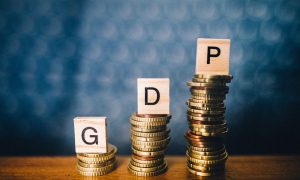New Delhi: The Indian economy faces a significant external risk as three of the six largest economies face a contraction, according to the latest data published by these countries last week.
Read More: Eiffel Tower Closes as Staff Goes on Strike
Japan and the UK both entered a technical recession after showing economic contraction in two consecutive quarters. Japanese economic data released Thursday pointed to a 0.4 percent contraction in the October-December 2023 quarter, following a 3.3 percent contraction in the preceding quarter.
In the same period, the UK’s economy contracted by 0.3 percent in the three months from October to December, following a 0.1 percent contraction in the preceding quarter between July and September — sealing its slump into a technical recession, according to a Reuters report.
Japan’s negative growth, during this period, has seen Germany replace it as the world’s third-largest economy.
Tokyo’s nominal Gross Domestic Product (GDP) stood at $4.21 trillion at the end of 2023, falling below Germany’s $4.46 trillion. Germany’s economy is forecast to show a 0.3 percent contraction for 2023 by the European Commission on 15 February.
With Germany, the UK and Japan all struggling, along with China admitting that its economy is facing “headwinds”, the four of the world’s top six economies have a tough 2024 ahead.
While the latest World Economic Outlook, published by the International Monetary Fund (IMF) on 30 January, forecasts an uptick in economic growth for India to 6.5 percent for 2024, the negative global scenario could see India feeling the pinch, Biswajit Dhar, vice-president and distinguished professor at the Council for Social Development, told ThePrint.
“When growth slides in the world’s largest economies, global sentiments are affected. It could lead to spending cuts and affect personal consumption — reflecting a lack of confidence in the economy,” said Dhar.
Bogging down of global economy will affect India
According to Dhar, India will start feeling the pain as the global economy slows down due to negative economic growth in Germany, the UK and Japan. He pointed out that, in 2024, India would require domestic demand to ensure robust growth.
Read More: Pakistan: Top Poll Body Forms High-Level Committee to Probe Allegations of Election Rigging
“India will have to rely more on domestic demand as the global economic growth slows down. There are two kinds of demand — foreign and domestic. Indian exports are dependent on the global economy, and with that falling, domestic demand will be required for the Indian economy,” said Dhar.
However, he pointed out that the falling investment situation in India is another sign linked to global investment sentiments. Foreign Direct Investment (FDI) in India during the first half of the 2023-2024 financial year (April-September) is the lowest in 16 years, as reported by ThePrint.
According to the Reserve Bank of India (RBI) figures, FDI stood at $10.1 billion between April and September 2023. The last time the amount was lower was in the first half of the 2007-2008 financial year when it was $8.2 billion.
As a percentage of India’s GDP, gross FDI flows dropped to just 1 percent in the first half of the 2023-2024 financial year, while net FDI fell to 0.6 percent, as reported by ThePrint.
While a global slowdown is one possible reason for shrinking FDI, analysis by ThePrint also shows that India’s share of global FDI has also been decreasing to a seven-year low.
Another analysis by ThePrint from April 2023 also highlights how private sector investment as a proportion of GDP has been falling consistently since 2012. While in absolute terms, private sector investment has seen an increase in proportion to the GDP, it fell to 19.6 percent of India’s GDP in 2020-21, according to ThePrint report.
Depressed investments, slowing retail sector
Dhar pointed out that investments would further be depressed because of the global situation, and also highlighted the slowing merchandise sales in India — showcasing the headwinds faced in the domestic economy.
Growth in discretionary retail sales in India slowed to just 9 percent year-on-year according to the Economic Times. Data made available by the Economic Times further shows that same-store sales growth was around 2 percent to 3 percent in 2023 — pointing out a slowdown in demand for consumer goods, such as clothes, shoes, cosmetics and fast food.
Same-store sales growth represents the values of goods sold at stores that are operational for at least a year. From October to December — a period with several festivals across India — saw a sales growth of only 6 percent, according to the Economic Times.
“Domestic demand is not looking good. Private investment is also not flowing,” explained Dhar, adding that the Union government has attempted to boost the domestic economy in its February budget with an increase in capital expenditure.
Read More: Donald Trump Fined $355 Million in Fraud Case. What Does This Mean for His Campaign, Finances?
“The belief was that global savings and investment flowing out of China would enter India. However, such investment has been subdued and will affect the Indian economy going forward,” Dhar added.





































